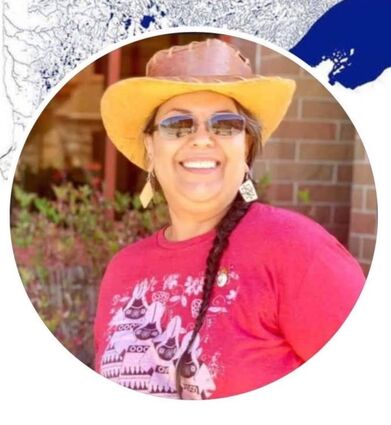Food Sources: Cooking with love and melding tradition
June 18, 2021
When you watch good cooks in action, all their senses are engaged. They are tuned into how the sauce feels against the spoon, whether the vegetables are glistening as they are sauteed, how the bread sounds when the baking crust is tapped, what the sweet, sour, salty, savory, bitter tastes need to stand out or blend.
Many languages describe what cooks are searching for. The Japanese call it "umami," which means the "essence of deliciousness."
I like the deeper meaning expressed by the Arabic word "nafas," meaning cooking with love, passion and positive energy. We all know that when we are hassled and hurried, supper tastes that way. When we cook with tenderness and attention, the people we feed feel nourished and cherished.
Debra Topping cooks this way. I first met Debra when she catered lunch for the Missing and Murdered Indigenous Women conference attendees last year at the Fond du Lac Tribal and Community College. There was baked walleye, wild rice, a beautiful salad and wojaapii, a delicious blueberry sauce for fry bread dipping. Every mouthful of the First Foods Feast conveyed her hopefulness that our meeting would lead to better times.
When Debra agreed to work with me on this column about nafas, her family said her manomin (wild rice) pumpkin harvest recipe was full of the loving attention we're looking for.
She says it starts with wild ricing.
"First we put our asemaa (tobacco) down and say our thanks to nibiinaabe (water spirit) and manomin and to Manido (Great Spirit). ... While I am gathering, I'm always in prayer, saying thanks for giving us this food of life. And then cooking it, I pray that the people who eat it will feel loved and nourished."
It's true for all the other ingredients too. Debra's friend brought her well-preserved, organic pumpkin seeds a few weeks ago. They told the seeds they respected and loved them "just like you would tell your grandmother," she said. When she tilled the garden soil and planted the seeds, she told them she would take care of people with its fruit.
During the spring sugar bush season, Debra says, "I tell the aninaatig (maple tree) that we are honored that we are able to continue gathering sap as our ancestors have done for millenia - being together, breathing fresh air and gathering food together is medicine."
Debra has a relationship with the onions, potatoes, and carrots growing in her garden. She gently cares for the compost, the soil, the seedlings, and even the weeds.
This is a whole new level of nafas. I wanted to know the Ojibwe word for this creative process, so I consulted with Jeff Savage at the Fond du Lac Museum and Cultural Center. He called his panel of Ojibwe language experts who said the term is "minoinizekwe," meaning "to cook in a good way."
Lois Ellen Frank is a Kiowa Santa Fe chef, author and food historian. She says Native cuisine is "a kind of dance based on a profound understanding of the ecosystem: when to plant; when animals migrate; when is best for seasonal composting." She says that this traditional ecological science brings the "wisdom of the ancestors that was handed down through generations, via traditional songs, stories and beliefs."
As we tend to our gardens this summer, we'll be listening to Debra's indigenous wisdom as we thank the seeds and plants whose flavors and textures will be appreciated at next fall's harvest meals with our loved ones.
*******
Manomin (Wild Rice) Pumpkin Harvest
This recipe calls for venison, and Debra usually makes a vegan version as well.
Ingredients
1 cup wild rice
1 6-8 lb sugar pumpkin
2 teaspoons salt
2 tablespoons bacon grease (vegetable oil for the vegan version)
1 pound ground venison (skip for vegan version)
1 large onion, chopped
2 large carrots, chopped
2-3 sweet or russet potatoes, unpeeled and chopped
1 teaspoon maple syrup
1 can of mushroom soup (vegan for vegan version)
1 teaspoon dried sage
½ teaspoon ground black pepper
Directions
Step 1: Clean and rinse manomin. In a saucepan, bring 3 cups of water to a boil. Add wild rice and cook for 3 minutes. Cover and remove from heat until tender, about 20 minutes.
Step 2: Parboil potatoes and carrots for 5 minutes. Drain.
Step 3: Preheat oven to 350 degrees F (175 degrees C).
Step 4: Remove the pumpkin top and scoop out pulp and seeds. Prick the pumpkin interior with a fork and rub with maple syrup.
Step 5: Heat bacon grease in a large skillet over medium-high heat. Stir in the ground venison and onion. Slowly cook and stir until evenly brown. Remove from heat. (Saute the onion in vegetable oil for the vegan version.)
Step 6: Mix in the wild rice, salt, mushroom soup, sage and pepper into the venison (or sauteed onion) and stuff the pumpkin with the mixture. Put the pumpkin top in place and grease the outside of the pumpkin. Place pumpkin in a shallow baking pan with 1/2 inch water.
Step 7: Bake the pumpkin in the preheated oven for 45 minutes to 1 hour, or until the flesh is tender.
Step 8: Place on a serving dish. Scoop pumpkin flesh with rice mixture to serve.









